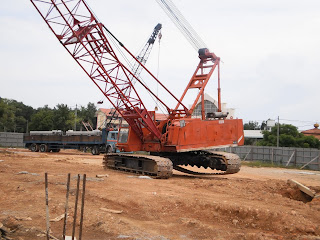DAY 7 (13 APR 2010)It was a quiet day at the office. So far the work progress here is still in the ground works. So from the electrical point of view, it's still too early to start any major wiring other than the earthing for some blocks and lightning protection. At the moment, more work is being done on the sanitary systems, laying of pipes underground. So for the time being, my exposure here will be more towards the groundworks and piping system. Hopefully my 3 months here will be enough to give me a chance see the electrical works being carried out.
Nevertheless, although so far what I've learnt here has very little to do with EE, but it any way, I have learnt quite a lot of what goes around in a construction area albeit the theory part only. You can say that I've been exposed to the civil & structural works here as well.
This is how things start out, with piles driven deep into the ground.

Next come the columns:

Then the ground beams:

Next the underground services i.e pipes, earthing etc:

And then the concrete floor:

That's basically how the foundation of a building is laid. Of course, it's easier said than done.
DAY 8 - 14 APRIL 2010
I
started the day by visiting the site to see the works that were going on. Initially I thought that the day was going to be like the day before, free and easy, and a bit boring. But low and behold, little did I know that it was going to be a long day at the office, literally.
In the morning I just went around the site observing work being done. Pretty easy and it beats sitting in the office doing nothing.




After lunch I was given some task to do. Initially I thought that it was going to be an easy on since it was just typing and keying in data. So I happily accepted it since I had nothing to do at that time. Well, as it turned out, it wasn't so straight forward. Firstly, the worksheet was in Excel. Of all the Microsoft Office programs, this is the one that I had least knowledge. My task was just to modify the tables, add a few columns here and there, then key in the data. Thing is, I wasn't sure of my way around Excel. Heck, I "forgot" how to even merge cells and create borders.
Well, like any of the people my age when we don't know something and want to save face by not saying that we don't know how to do something that we should know, I requested the help of my good friend, Mr Google. Got some answers there. But it was pretty slow. So I then decided to ask the QA/QC engineer for a help. At least she was kind enough to help me out. So once I found my way around, things were pretty straight forward. But worst was to come. After taking my sweet time finish modifying one table and keying in the data, I realised that I had about 30 tables to modify and fill up. And I took about 20 minutes relaxing between work and FB to do the first table and it was nearly 4pm. Well, hook or by crook, I had to get it done since they needed it the next day.
And so I stayed back after working hours to complete the task.I had the air-cond here and it wasn't as if I had something to do back home. There were others as well who stayed back completing their work, so I wasn't alone. And another plus point, my boss bought us dinner, KFC. I wouldn't mind staying back if he does it everytime.
I managed to finish my task at about 10pm. It was indeed a long day. But it was better than nothing. So that was how my day went.
DAY 9 - 15 APR 2010It was a less hectic day today. Started of the morning at the site observing work being done, especially on the concrete works.









 The project here uses the Intelligent-Building-Systems of IBS. The slabs, columns and walls are precasted before fitted in place, as can be seen here.
The project here uses the Intelligent-Building-Systems of IBS. The slabs, columns and walls are precasted before fitted in place, as can be seen here. The picture above show the Damp-prove-membrane. It's a plastic sheet that is placed on the ground before concreting works a carried out to prevent water from seaping out of the ground in future.
The picture above show the Damp-prove-membrane. It's a plastic sheet that is placed on the ground before concreting works a carried out to prevent water from seaping out of the ground in future.













































